TAEASS403 Task: Validating BSBTWK201 Assessment Tool Analysis
VerifiedAdded on 2023/06/05
|39
|13431
|262
Practical Assignment
AI Summary
This assignment focuses on the TAEASS403 unit, requiring the student to participate in the assessment validation process for a newly-written assessment tool designed for the BSBTWK201 unit (Work effectively with others). The task involves a team of at least two participants, including the student, who work together to analyze the unit of competency, agree on the evidence needed to demonstrate competence, and then validate the draft assessment tool. The validation process includes reviewing the assessment tool for clarity, completeness, and alignment with the competency standards, as well as identifying any gaps or areas for improvement. The student is required to provide handwritten comments on the draft assessment tool to authenticate their participation and demonstrate their analysis. The assignment also includes a review and reflection questionnaire, and the student must submit the analyzed unit of competency, the draft assessment tool with comments, and the completed validation record.
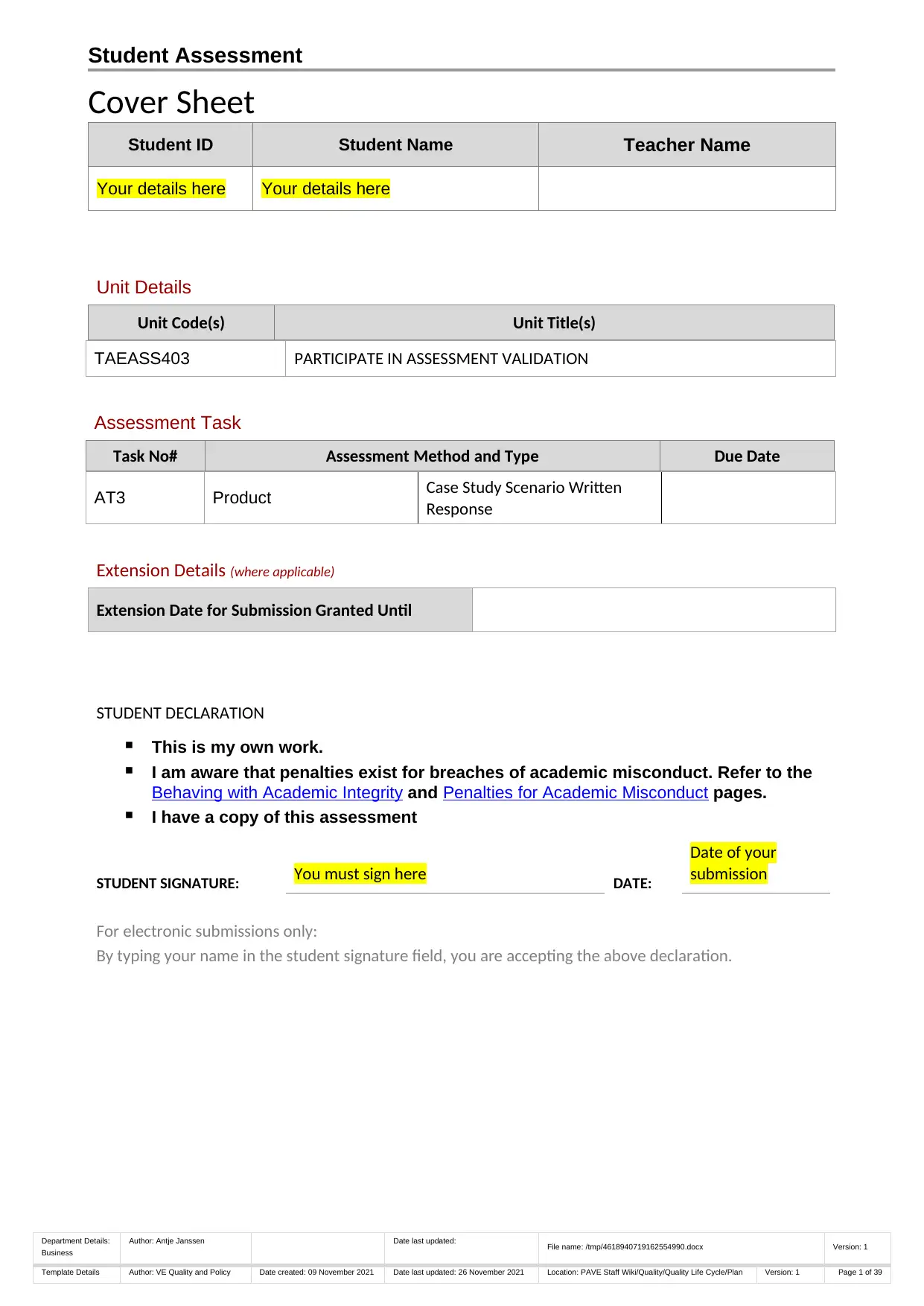
Student Assessment
Cover Sheet
Student ID Student Name Teacher Name
Your details here Your details here
Unit Details
Unit Code(s) Unit Title(s)
TAEASS403 PARTICIPATE IN ASSESSMENT VALIDATION
Assessment Task
Task No# Assessment Method and Type Due Date
AT3 Product Case Study Scenario Written
Response
Extension Details (where applicable)
Extension Date for Submission Granted Until
STUDENT DECLARATION
This is my own work.
I am aware that penalties exist for breaches of academic misconduct. Refer to the
Behaving with Academic Integrity and Penalties for Academic Misconduct pages.
I have a copy of this assessment
STUDENT SIGNATURE: You must sign here DATE:
Date of your
submission
For electronic submissions only:
By typing your name in the student signature field, you are accepting the above declaration.
Department Details:
Business
Author: Antje Janssen Date last updated: File name: /tmp/4618940719162554990.docx Version: 1
Template Details Author: VE Quality and Policy Date created: 09 November 2021 Date last updated: 26 November 2021 Location: PAVE Staff Wiki/Quality/Quality Life Cycle/Plan Version: 1 Page 1 of 39
Cover Sheet
Student ID Student Name Teacher Name
Your details here Your details here
Unit Details
Unit Code(s) Unit Title(s)
TAEASS403 PARTICIPATE IN ASSESSMENT VALIDATION
Assessment Task
Task No# Assessment Method and Type Due Date
AT3 Product Case Study Scenario Written
Response
Extension Details (where applicable)
Extension Date for Submission Granted Until
STUDENT DECLARATION
This is my own work.
I am aware that penalties exist for breaches of academic misconduct. Refer to the
Behaving with Academic Integrity and Penalties for Academic Misconduct pages.
I have a copy of this assessment
STUDENT SIGNATURE: You must sign here DATE:
Date of your
submission
For electronic submissions only:
By typing your name in the student signature field, you are accepting the above declaration.
Department Details:
Business
Author: Antje Janssen Date last updated: File name: /tmp/4618940719162554990.docx Version: 1
Template Details Author: VE Quality and Policy Date created: 09 November 2021 Date last updated: 26 November 2021 Location: PAVE Staff Wiki/Quality/Quality Life Cycle/Plan Version: 1 Page 1 of 39
Paraphrase This Document
Need a fresh take? Get an instant paraphrase of this document with our AI Paraphraser
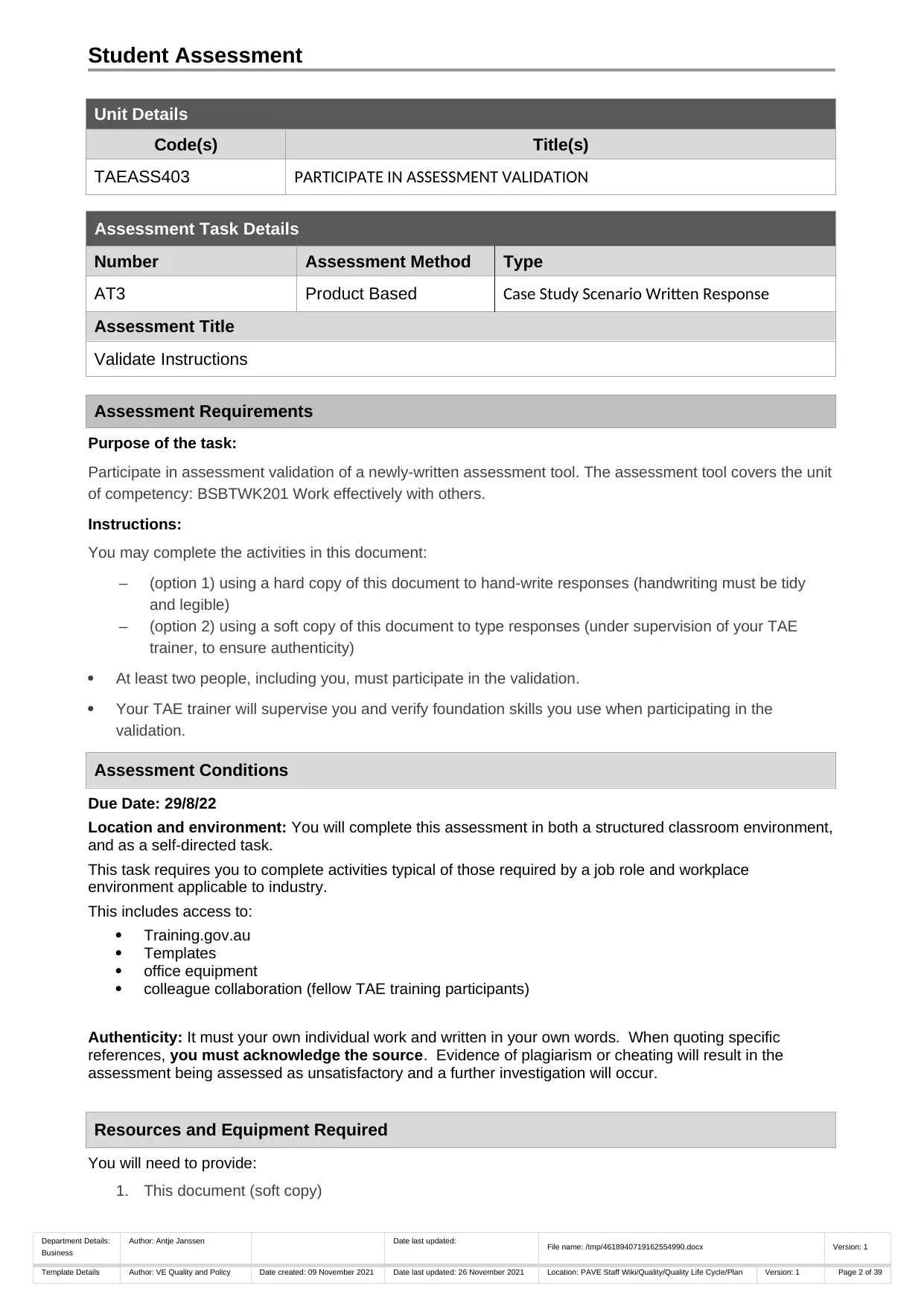
Student Assessment
Unit Details
Code(s) Title(s)
TAEASS403 PARTICIPATE IN ASSESSMENT VALIDATION
Assessment Task Details
Number Assessment Method Type
AT3 Product Based Case Study Scenario Written Response
Assessment Title
Validate Instructions
Assessment Requirements
Purpose of the task:
Participate in assessment validation of a newly-written assessment tool. The assessment tool covers the unit
of competency: BSBTWK201 Work effectively with others.
Instructions:
You may complete the activities in this document:
– (option 1) using a hard copy of this document to hand-write responses (handwriting must be tidy
and legible)
– (option 2) using a soft copy of this document to type responses (under supervision of your TAE
trainer, to ensure authenticity)
At least two people, including you, must participate in the validation.
Your TAE trainer will supervise you and verify foundation skills you use when participating in the
validation.
Assessment Conditions
Due Date: 29/8/22
Location and environment: You will complete this assessment in both a structured classroom environment,
and as a self-directed task.
This task requires you to complete activities typical of those required by a job role and workplace
environment applicable to industry.
This includes access to:
Training.gov.au
Templates
office equipment
colleague collaboration (fellow TAE training participants)
Authenticity: It must your own individual work and written in your own words. When quoting specific
references, you must acknowledge the source. Evidence of plagiarism or cheating will result in the
assessment being assessed as unsatisfactory and a further investigation will occur.
Resources and Equipment Required
You will need to provide:
1. This document (soft copy)
Department Details:
Business
Author: Antje Janssen Date last updated: File name: /tmp/4618940719162554990.docx Version: 1
Template Details Author: VE Quality and Policy Date created: 09 November 2021 Date last updated: 26 November 2021 Location: PAVE Staff Wiki/Quality/Quality Life Cycle/Plan Version: 1 Page 2 of 39
Unit Details
Code(s) Title(s)
TAEASS403 PARTICIPATE IN ASSESSMENT VALIDATION
Assessment Task Details
Number Assessment Method Type
AT3 Product Based Case Study Scenario Written Response
Assessment Title
Validate Instructions
Assessment Requirements
Purpose of the task:
Participate in assessment validation of a newly-written assessment tool. The assessment tool covers the unit
of competency: BSBTWK201 Work effectively with others.
Instructions:
You may complete the activities in this document:
– (option 1) using a hard copy of this document to hand-write responses (handwriting must be tidy
and legible)
– (option 2) using a soft copy of this document to type responses (under supervision of your TAE
trainer, to ensure authenticity)
At least two people, including you, must participate in the validation.
Your TAE trainer will supervise you and verify foundation skills you use when participating in the
validation.
Assessment Conditions
Due Date: 29/8/22
Location and environment: You will complete this assessment in both a structured classroom environment,
and as a self-directed task.
This task requires you to complete activities typical of those required by a job role and workplace
environment applicable to industry.
This includes access to:
Training.gov.au
Templates
office equipment
colleague collaboration (fellow TAE training participants)
Authenticity: It must your own individual work and written in your own words. When quoting specific
references, you must acknowledge the source. Evidence of plagiarism or cheating will result in the
assessment being assessed as unsatisfactory and a further investigation will occur.
Resources and Equipment Required
You will need to provide:
1. This document (soft copy)
Department Details:
Business
Author: Antje Janssen Date last updated: File name: /tmp/4618940719162554990.docx Version: 1
Template Details Author: VE Quality and Policy Date created: 09 November 2021 Date last updated: 26 November 2021 Location: PAVE Staff Wiki/Quality/Quality Life Cycle/Plan Version: 1 Page 2 of 39
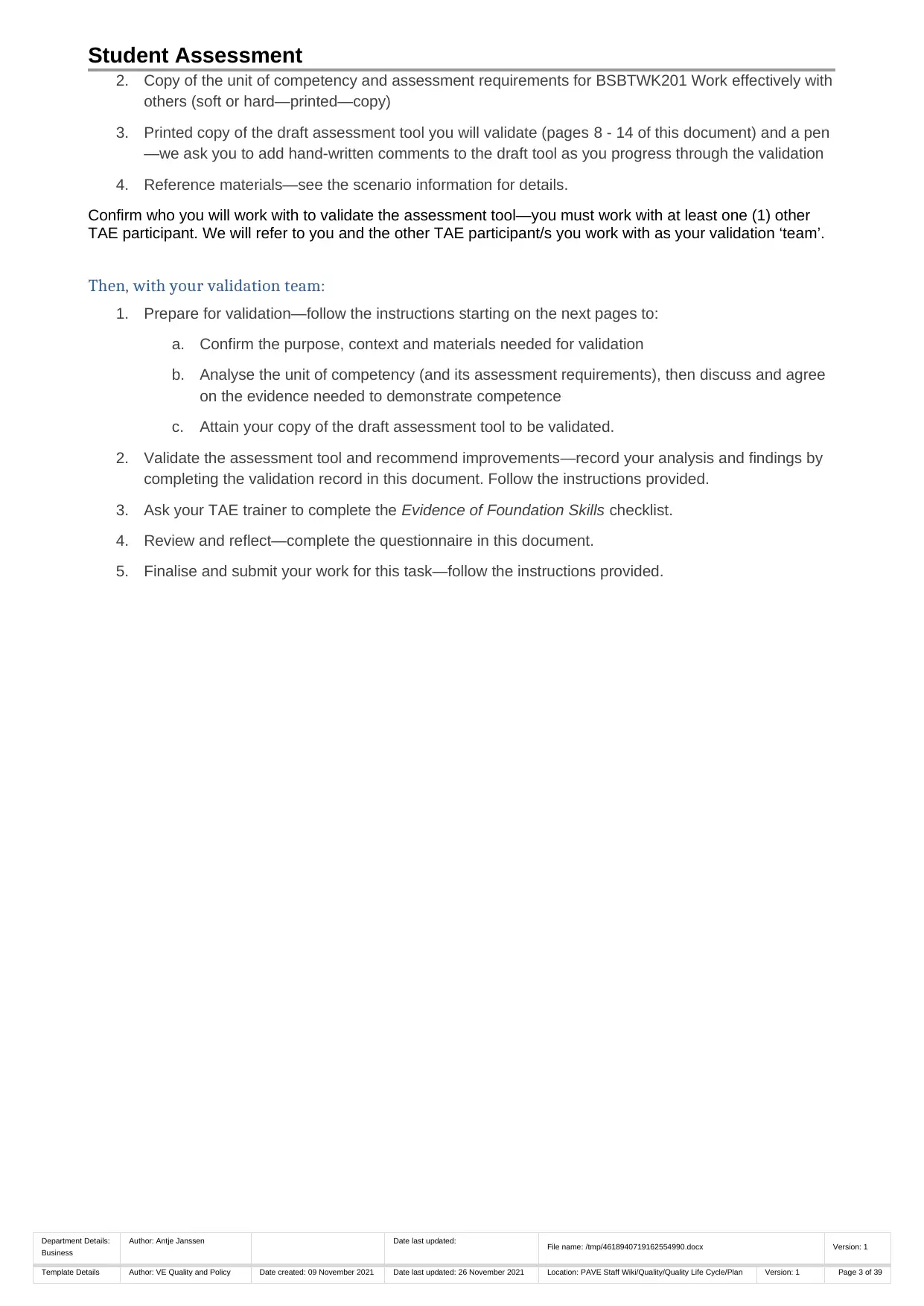
Student Assessment
2. Copy of the unit of competency and assessment requirements for BSBTWK201 Work effectively with
others (soft or hard—printed—copy)
3. Printed copy of the draft assessment tool you will validate (pages 8 - 14 of this document) and a pen
—we ask you to add hand-written comments to the draft tool as you progress through the validation
4. Reference materials—see the scenario information for details.
Confirm who you will work with to validate the assessment tool—you must work with at least one (1) other
TAE participant. We will refer to you and the other TAE participant/s you work with as your validation ‘team’.
Then, with your validation team:
1. Prepare for validation—follow the instructions starting on the next pages to:
a. Confirm the purpose, context and materials needed for validation
b. Analyse the unit of competency (and its assessment requirements), then discuss and agree
on the evidence needed to demonstrate competence
c. Attain your copy of the draft assessment tool to be validated.
2. Validate the assessment tool and recommend improvements—record your analysis and findings by
completing the validation record in this document. Follow the instructions provided.
3. Ask your TAE trainer to complete the Evidence of Foundation Skills checklist.
4. Review and reflect—complete the questionnaire in this document.
5. Finalise and submit your work for this task—follow the instructions provided.
Department Details:
Business
Author: Antje Janssen Date last updated: File name: /tmp/4618940719162554990.docx Version: 1
Template Details Author: VE Quality and Policy Date created: 09 November 2021 Date last updated: 26 November 2021 Location: PAVE Staff Wiki/Quality/Quality Life Cycle/Plan Version: 1 Page 3 of 39
2. Copy of the unit of competency and assessment requirements for BSBTWK201 Work effectively with
others (soft or hard—printed—copy)
3. Printed copy of the draft assessment tool you will validate (pages 8 - 14 of this document) and a pen
—we ask you to add hand-written comments to the draft tool as you progress through the validation
4. Reference materials—see the scenario information for details.
Confirm who you will work with to validate the assessment tool—you must work with at least one (1) other
TAE participant. We will refer to you and the other TAE participant/s you work with as your validation ‘team’.
Then, with your validation team:
1. Prepare for validation—follow the instructions starting on the next pages to:
a. Confirm the purpose, context and materials needed for validation
b. Analyse the unit of competency (and its assessment requirements), then discuss and agree
on the evidence needed to demonstrate competence
c. Attain your copy of the draft assessment tool to be validated.
2. Validate the assessment tool and recommend improvements—record your analysis and findings by
completing the validation record in this document. Follow the instructions provided.
3. Ask your TAE trainer to complete the Evidence of Foundation Skills checklist.
4. Review and reflect—complete the questionnaire in this document.
5. Finalise and submit your work for this task—follow the instructions provided.
Department Details:
Business
Author: Antje Janssen Date last updated: File name: /tmp/4618940719162554990.docx Version: 1
Template Details Author: VE Quality and Policy Date created: 09 November 2021 Date last updated: 26 November 2021 Location: PAVE Staff Wiki/Quality/Quality Life Cycle/Plan Version: 1 Page 3 of 39
⊘ This is a preview!⊘
Do you want full access?
Subscribe today to unlock all pages.

Trusted by 1+ million students worldwide
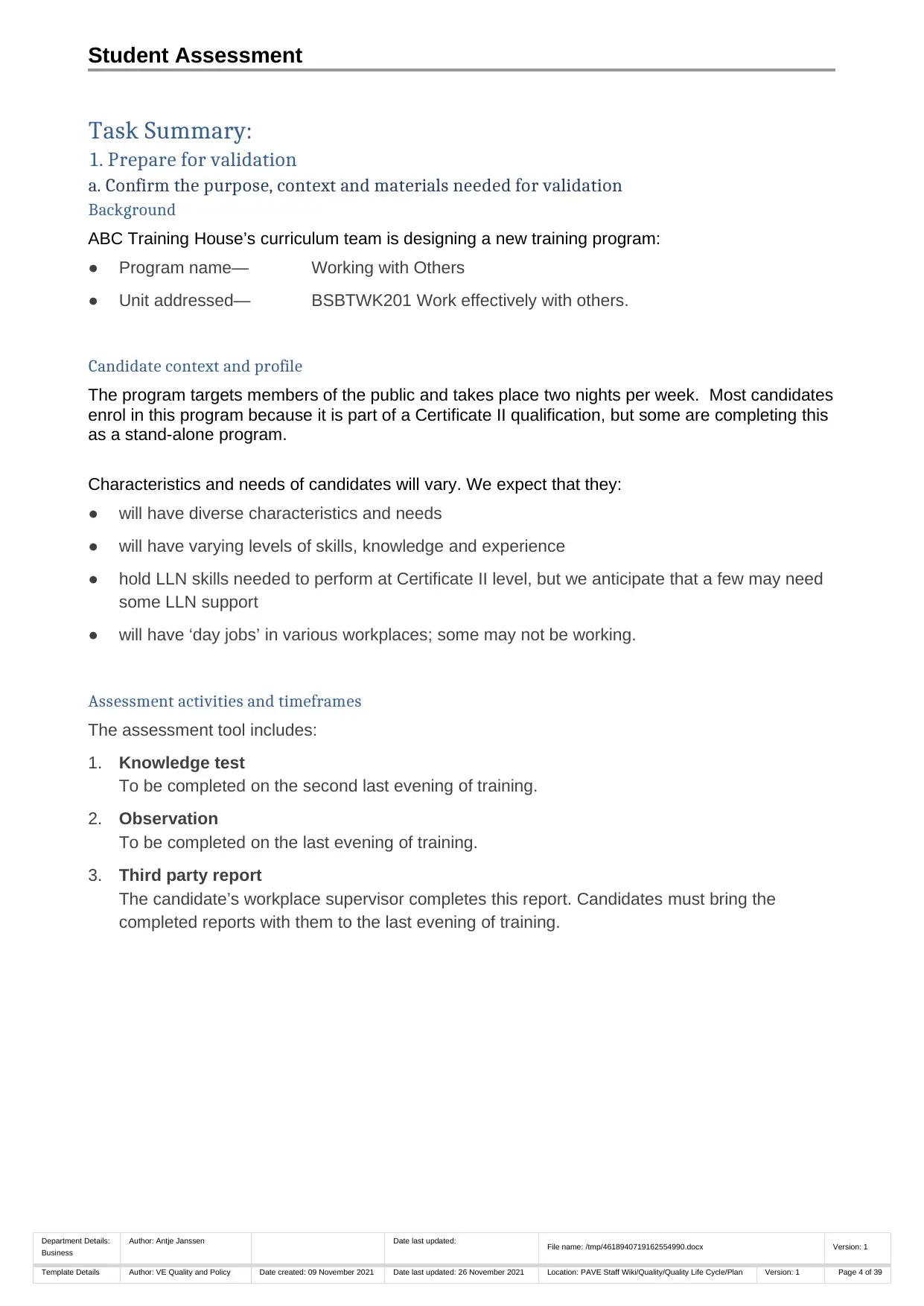
Student Assessment
Task Summary:
1. Prepare for validation
a. Confirm the purpose, context and materials needed for validation
Background
ABC Training House’s curriculum team is designing a new training program:
● Program name— Working with Others
● Unit addressed— BSBTWK201 Work effectively with others.
Candidate context and profile
The program targets members of the public and takes place two nights per week. Most candidates
enrol in this program because it is part of a Certificate II qualification, but some are completing this
as a stand-alone program.
Characteristics and needs of candidates will vary. We expect that they:
● will have diverse characteristics and needs
● will have varying levels of skills, knowledge and experience
● hold LLN skills needed to perform at Certificate II level, but we anticipate that a few may need
some LLN support
● will have ‘day jobs’ in various workplaces; some may not be working.
Assessment activities and timeframes
The assessment tool includes:
1. Knowledge test
To be completed on the second last evening of training.
2. Observation
To be completed on the last evening of training.
3. Third party report
The candidate’s workplace supervisor completes this report. Candidates must bring the
completed reports with them to the last evening of training.
Department Details:
Business
Author: Antje Janssen Date last updated: File name: /tmp/4618940719162554990.docx Version: 1
Template Details Author: VE Quality and Policy Date created: 09 November 2021 Date last updated: 26 November 2021 Location: PAVE Staff Wiki/Quality/Quality Life Cycle/Plan Version: 1 Page 4 of 39
Task Summary:
1. Prepare for validation
a. Confirm the purpose, context and materials needed for validation
Background
ABC Training House’s curriculum team is designing a new training program:
● Program name— Working with Others
● Unit addressed— BSBTWK201 Work effectively with others.
Candidate context and profile
The program targets members of the public and takes place two nights per week. Most candidates
enrol in this program because it is part of a Certificate II qualification, but some are completing this
as a stand-alone program.
Characteristics and needs of candidates will vary. We expect that they:
● will have diverse characteristics and needs
● will have varying levels of skills, knowledge and experience
● hold LLN skills needed to perform at Certificate II level, but we anticipate that a few may need
some LLN support
● will have ‘day jobs’ in various workplaces; some may not be working.
Assessment activities and timeframes
The assessment tool includes:
1. Knowledge test
To be completed on the second last evening of training.
2. Observation
To be completed on the last evening of training.
3. Third party report
The candidate’s workplace supervisor completes this report. Candidates must bring the
completed reports with them to the last evening of training.
Department Details:
Business
Author: Antje Janssen Date last updated: File name: /tmp/4618940719162554990.docx Version: 1
Template Details Author: VE Quality and Policy Date created: 09 November 2021 Date last updated: 26 November 2021 Location: PAVE Staff Wiki/Quality/Quality Life Cycle/Plan Version: 1 Page 4 of 39
Paraphrase This Document
Need a fresh take? Get an instant paraphrase of this document with our AI Paraphraser
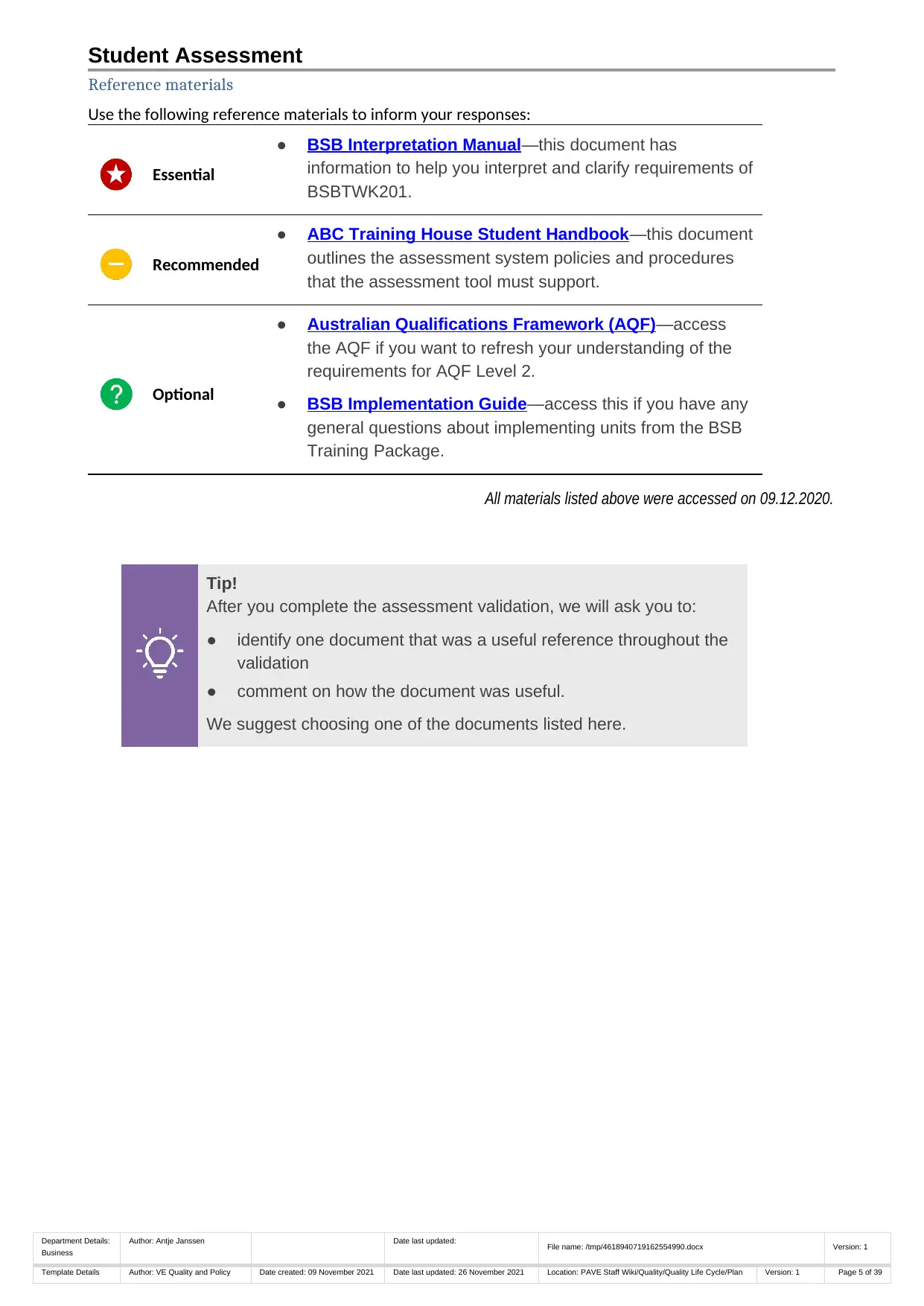
Student Assessment
Reference materials
Use the following reference materials to inform your responses:
Essential
● BSB Interpretation Manual—this document has
information to help you interpret and clarify requirements of
BSBTWK201.
Recommended
● ABC Training House Student Handbook—this document
outlines the assessment system policies and procedures
that the assessment tool must support.
Optional
● Australian Qualifications Framework (AQF)—access
the AQF if you want to refresh your understanding of the
requirements for AQF Level 2.
● BSB Implementation Guide—access this if you have any
general questions about implementing units from the BSB
Training Package.
All materials listed above were accessed on 09.12.2020.
Tip!
After you complete the assessment validation, we will ask you to:
● identify one document that was a useful reference throughout the
validation
● comment on how the document was useful.
We suggest choosing one of the documents listed here.
Department Details:
Business
Author: Antje Janssen Date last updated: File name: /tmp/4618940719162554990.docx Version: 1
Template Details Author: VE Quality and Policy Date created: 09 November 2021 Date last updated: 26 November 2021 Location: PAVE Staff Wiki/Quality/Quality Life Cycle/Plan Version: 1 Page 5 of 39
Reference materials
Use the following reference materials to inform your responses:
Essential
● BSB Interpretation Manual—this document has
information to help you interpret and clarify requirements of
BSBTWK201.
Recommended
● ABC Training House Student Handbook—this document
outlines the assessment system policies and procedures
that the assessment tool must support.
Optional
● Australian Qualifications Framework (AQF)—access
the AQF if you want to refresh your understanding of the
requirements for AQF Level 2.
● BSB Implementation Guide—access this if you have any
general questions about implementing units from the BSB
Training Package.
All materials listed above were accessed on 09.12.2020.
Tip!
After you complete the assessment validation, we will ask you to:
● identify one document that was a useful reference throughout the
validation
● comment on how the document was useful.
We suggest choosing one of the documents listed here.
Department Details:
Business
Author: Antje Janssen Date last updated: File name: /tmp/4618940719162554990.docx Version: 1
Template Details Author: VE Quality and Policy Date created: 09 November 2021 Date last updated: 26 November 2021 Location: PAVE Staff Wiki/Quality/Quality Life Cycle/Plan Version: 1 Page 5 of 39
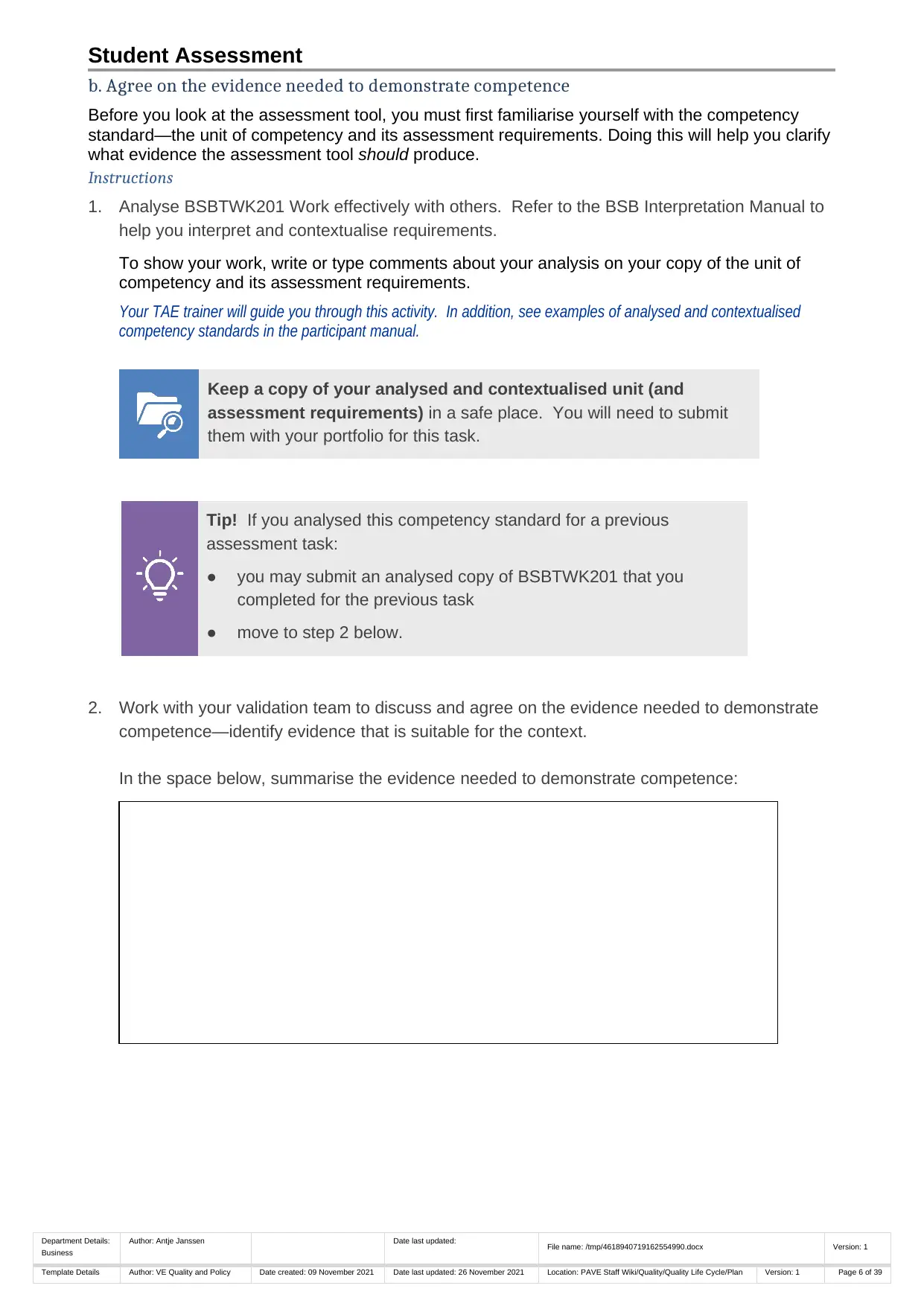
Student Assessment
b. Agree on the evidence needed to demonstrate competence
Before you look at the assessment tool, you must first familiarise yourself with the competency
standard—the unit of competency and its assessment requirements. Doing this will help you clarify
what evidence the assessment tool should produce.
Instructions
1. Analyse BSBTWK201 Work effectively with others. Refer to the BSB Interpretation Manual to
help you interpret and contextualise requirements.
To show your work, write or type comments about your analysis on your copy of the unit of
competency and its assessment requirements.
Your TAE trainer will guide you through this activity. In addition, see examples of analysed and contextualised
competency standards in the participant manual.
Keep a copy of your analysed and contextualised unit (and
assessment requirements) in a safe place. You will need to submit
them with your portfolio for this task.
Tip! If you analysed this competency standard for a previous
assessment task:
● you may submit an analysed copy of BSBTWK201 that you
completed for the previous task
● move to step 2 below.
2. Work with your validation team to discuss and agree on the evidence needed to demonstrate
competence—identify evidence that is suitable for the context.
In the space below, summarise the evidence needed to demonstrate competence:
Department Details:
Business
Author: Antje Janssen Date last updated: File name: /tmp/4618940719162554990.docx Version: 1
Template Details Author: VE Quality and Policy Date created: 09 November 2021 Date last updated: 26 November 2021 Location: PAVE Staff Wiki/Quality/Quality Life Cycle/Plan Version: 1 Page 6 of 39
b. Agree on the evidence needed to demonstrate competence
Before you look at the assessment tool, you must first familiarise yourself with the competency
standard—the unit of competency and its assessment requirements. Doing this will help you clarify
what evidence the assessment tool should produce.
Instructions
1. Analyse BSBTWK201 Work effectively with others. Refer to the BSB Interpretation Manual to
help you interpret and contextualise requirements.
To show your work, write or type comments about your analysis on your copy of the unit of
competency and its assessment requirements.
Your TAE trainer will guide you through this activity. In addition, see examples of analysed and contextualised
competency standards in the participant manual.
Keep a copy of your analysed and contextualised unit (and
assessment requirements) in a safe place. You will need to submit
them with your portfolio for this task.
Tip! If you analysed this competency standard for a previous
assessment task:
● you may submit an analysed copy of BSBTWK201 that you
completed for the previous task
● move to step 2 below.
2. Work with your validation team to discuss and agree on the evidence needed to demonstrate
competence—identify evidence that is suitable for the context.
In the space below, summarise the evidence needed to demonstrate competence:
Department Details:
Business
Author: Antje Janssen Date last updated: File name: /tmp/4618940719162554990.docx Version: 1
Template Details Author: VE Quality and Policy Date created: 09 November 2021 Date last updated: 26 November 2021 Location: PAVE Staff Wiki/Quality/Quality Life Cycle/Plan Version: 1 Page 6 of 39
⊘ This is a preview!⊘
Do you want full access?
Subscribe today to unlock all pages.

Trusted by 1+ million students worldwide

Student Assessment
c. Attain your copy of the draft assessment tool that you will validate
Print your draft tool or get a copy from your TAE trainer
As you progress through the validation, hand-write comments on the draft tool. Your comments
will:
● authenticate your participation in the assessment validation
● show how you analysed and critiqued the assessment tool while validating.
Your comments may show where you identified:
● typos
● assessment instructions that are incomplete, unclear, unnecessary or inappropriate
● competency gaps
● reference to parts of the unit or assessment requirements that are covered with a particular
assessment question or activity
● comments for improvement or about strengths of the tool.
You will need to provide a scanned copy of the draft assessment tool that has
your hand-written comments.
The draft assessment tool begins on the next page.
Department Details:
Business
Author: Antje Janssen Date last updated: File name: /tmp/4618940719162554990.docx Version: 1
Template Details Author: VE Quality and Policy Date created: 09 November 2021 Date last updated: 26 November 2021 Location: PAVE Staff Wiki/Quality/Quality Life Cycle/Plan Version: 1 Page 7 of 39
c. Attain your copy of the draft assessment tool that you will validate
Print your draft tool or get a copy from your TAE trainer
As you progress through the validation, hand-write comments on the draft tool. Your comments
will:
● authenticate your participation in the assessment validation
● show how you analysed and critiqued the assessment tool while validating.
Your comments may show where you identified:
● typos
● assessment instructions that are incomplete, unclear, unnecessary or inappropriate
● competency gaps
● reference to parts of the unit or assessment requirements that are covered with a particular
assessment question or activity
● comments for improvement or about strengths of the tool.
You will need to provide a scanned copy of the draft assessment tool that has
your hand-written comments.
The draft assessment tool begins on the next page.
Department Details:
Business
Author: Antje Janssen Date last updated: File name: /tmp/4618940719162554990.docx Version: 1
Template Details Author: VE Quality and Policy Date created: 09 November 2021 Date last updated: 26 November 2021 Location: PAVE Staff Wiki/Quality/Quality Life Cycle/Plan Version: 1 Page 7 of 39
Paraphrase This Document
Need a fresh take? Get an instant paraphrase of this document with our AI Paraphraser

Student Assessment
The assessment tool to be validated
Assessment tool:
BSBWOR203 Work effectively with others
Assessment cover sheet and record of results
General assessment information
Candidate name
Candidate workplace
Assessor name
Assessment results
Assessors, after completing the assessment, record results here:
Result Competent Not Yet Competent
Comments and
action plan (if required)
Assessor signature
Date signed
Instructions for candidates
Task 1: Knowledge Test
To be written during training, in the second-last session
Complete the test within the time allocated and return to your trainer when finished.
Task 2: Practical Scenarios
To be completed during training, in the last session
You will be observed working as part of a team as part of a role play scenario.
Task 3: Third party report
Completed form to be submitted on or before the last session
Ask a supervisor in your workplace to the third party report and bring to class on or before the last session
of this program.
Department Details:
Business
Author: Antje Janssen Date last updated: File name: /tmp/4618940719162554990.docx Version: 1
Template Details Author: VE Quality and Policy Date created: 09 November 2021 Date last updated: 26 November 2021 Location: PAVE Staff Wiki/Quality/Quality Life Cycle/Plan Version: 1 Page 8 of 39
The assessment tool to be validated
Assessment tool:
BSBWOR203 Work effectively with others
Assessment cover sheet and record of results
General assessment information
Candidate name
Candidate workplace
Assessor name
Assessment results
Assessors, after completing the assessment, record results here:
Result Competent Not Yet Competent
Comments and
action plan (if required)
Assessor signature
Date signed
Instructions for candidates
Task 1: Knowledge Test
To be written during training, in the second-last session
Complete the test within the time allocated and return to your trainer when finished.
Task 2: Practical Scenarios
To be completed during training, in the last session
You will be observed working as part of a team as part of a role play scenario.
Task 3: Third party report
Completed form to be submitted on or before the last session
Ask a supervisor in your workplace to the third party report and bring to class on or before the last session
of this program.
Department Details:
Business
Author: Antje Janssen Date last updated: File name: /tmp/4618940719162554990.docx Version: 1
Template Details Author: VE Quality and Policy Date created: 09 November 2021 Date last updated: 26 November 2021 Location: PAVE Staff Wiki/Quality/Quality Life Cycle/Plan Version: 1 Page 8 of 39
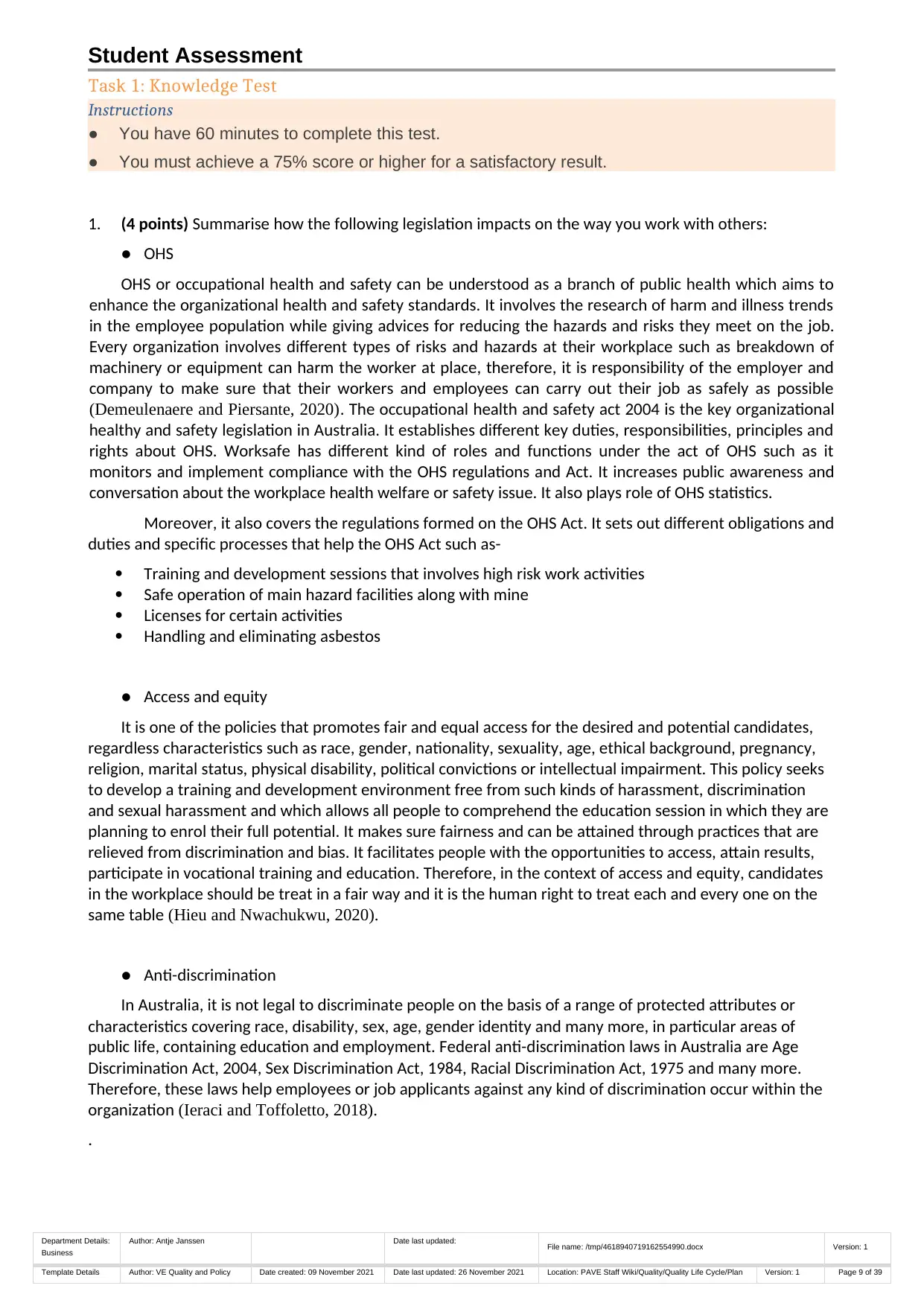
Student Assessment
Task 1: Knowledge Test
Instructions
● You have 60 minutes to complete this test.
● You must achieve a 75% score or higher for a satisfactory result.
1. (4 points) Summarise how the following legislation impacts on the way you work with others:
● OHS
OHS or occupational health and safety can be understood as a branch of public health which aims to
enhance the organizational health and safety standards. It involves the research of harm and illness trends
in the employee population while giving advices for reducing the hazards and risks they meet on the job.
Every organization involves different types of risks and hazards at their workplace such as breakdown of
machinery or equipment can harm the worker at place, therefore, it is responsibility of the employer and
company to make sure that their workers and employees can carry out their job as safely as possible
(Demeulenaere and Piersante, 2020). The occupational health and safety act 2004 is the key organizational
healthy and safety legislation in Australia. It establishes different key duties, responsibilities, principles and
rights about OHS. Worksafe has different kind of roles and functions under the act of OHS such as it
monitors and implement compliance with the OHS regulations and Act. It increases public awareness and
conversation about the workplace health welfare or safety issue. It also plays role of OHS statistics.
Moreover, it also covers the regulations formed on the OHS Act. It sets out different obligations and
duties and specific processes that help the OHS Act such as-
Training and development sessions that involves high risk work activities
Safe operation of main hazard facilities along with mine
Licenses for certain activities
Handling and eliminating asbestos
● Access and equity
It is one of the policies that promotes fair and equal access for the desired and potential candidates,
regardless characteristics such as race, gender, nationality, sexuality, age, ethical background, pregnancy,
religion, marital status, physical disability, political convictions or intellectual impairment. This policy seeks
to develop a training and development environment free from such kinds of harassment, discrimination
and sexual harassment and which allows all people to comprehend the education session in which they are
planning to enrol their full potential. It makes sure fairness and can be attained through practices that are
relieved from discrimination and bias. It facilitates people with the opportunities to access, attain results,
participate in vocational training and education. Therefore, in the context of access and equity, candidates
in the workplace should be treat in a fair way and it is the human right to treat each and every one on the
same table (Hieu and Nwachukwu, 2020).
● Anti-discrimination
In Australia, it is not legal to discriminate people on the basis of a range of protected attributes or
characteristics covering race, disability, sex, age, gender identity and many more, in particular areas of
public life, containing education and employment. Federal anti-discrimination laws in Australia are Age
Discrimination Act, 2004, Sex Discrimination Act, 1984, Racial Discrimination Act, 1975 and many more.
Therefore, these laws help employees or job applicants against any kind of discrimination occur within the
organization (Ieraci and Toffoletto, 2018).
.
Department Details:
Business
Author: Antje Janssen Date last updated: File name: /tmp/4618940719162554990.docx Version: 1
Template Details Author: VE Quality and Policy Date created: 09 November 2021 Date last updated: 26 November 2021 Location: PAVE Staff Wiki/Quality/Quality Life Cycle/Plan Version: 1 Page 9 of 39
Task 1: Knowledge Test
Instructions
● You have 60 minutes to complete this test.
● You must achieve a 75% score or higher for a satisfactory result.
1. (4 points) Summarise how the following legislation impacts on the way you work with others:
● OHS
OHS or occupational health and safety can be understood as a branch of public health which aims to
enhance the organizational health and safety standards. It involves the research of harm and illness trends
in the employee population while giving advices for reducing the hazards and risks they meet on the job.
Every organization involves different types of risks and hazards at their workplace such as breakdown of
machinery or equipment can harm the worker at place, therefore, it is responsibility of the employer and
company to make sure that their workers and employees can carry out their job as safely as possible
(Demeulenaere and Piersante, 2020). The occupational health and safety act 2004 is the key organizational
healthy and safety legislation in Australia. It establishes different key duties, responsibilities, principles and
rights about OHS. Worksafe has different kind of roles and functions under the act of OHS such as it
monitors and implement compliance with the OHS regulations and Act. It increases public awareness and
conversation about the workplace health welfare or safety issue. It also plays role of OHS statistics.
Moreover, it also covers the regulations formed on the OHS Act. It sets out different obligations and
duties and specific processes that help the OHS Act such as-
Training and development sessions that involves high risk work activities
Safe operation of main hazard facilities along with mine
Licenses for certain activities
Handling and eliminating asbestos
● Access and equity
It is one of the policies that promotes fair and equal access for the desired and potential candidates,
regardless characteristics such as race, gender, nationality, sexuality, age, ethical background, pregnancy,
religion, marital status, physical disability, political convictions or intellectual impairment. This policy seeks
to develop a training and development environment free from such kinds of harassment, discrimination
and sexual harassment and which allows all people to comprehend the education session in which they are
planning to enrol their full potential. It makes sure fairness and can be attained through practices that are
relieved from discrimination and bias. It facilitates people with the opportunities to access, attain results,
participate in vocational training and education. Therefore, in the context of access and equity, candidates
in the workplace should be treat in a fair way and it is the human right to treat each and every one on the
same table (Hieu and Nwachukwu, 2020).
● Anti-discrimination
In Australia, it is not legal to discriminate people on the basis of a range of protected attributes or
characteristics covering race, disability, sex, age, gender identity and many more, in particular areas of
public life, containing education and employment. Federal anti-discrimination laws in Australia are Age
Discrimination Act, 2004, Sex Discrimination Act, 1984, Racial Discrimination Act, 1975 and many more.
Therefore, these laws help employees or job applicants against any kind of discrimination occur within the
organization (Ieraci and Toffoletto, 2018).
.
Department Details:
Business
Author: Antje Janssen Date last updated: File name: /tmp/4618940719162554990.docx Version: 1
Template Details Author: VE Quality and Policy Date created: 09 November 2021 Date last updated: 26 November 2021 Location: PAVE Staff Wiki/Quality/Quality Life Cycle/Plan Version: 1 Page 9 of 39
⊘ This is a preview!⊘
Do you want full access?
Subscribe today to unlock all pages.

Trusted by 1+ million students worldwide
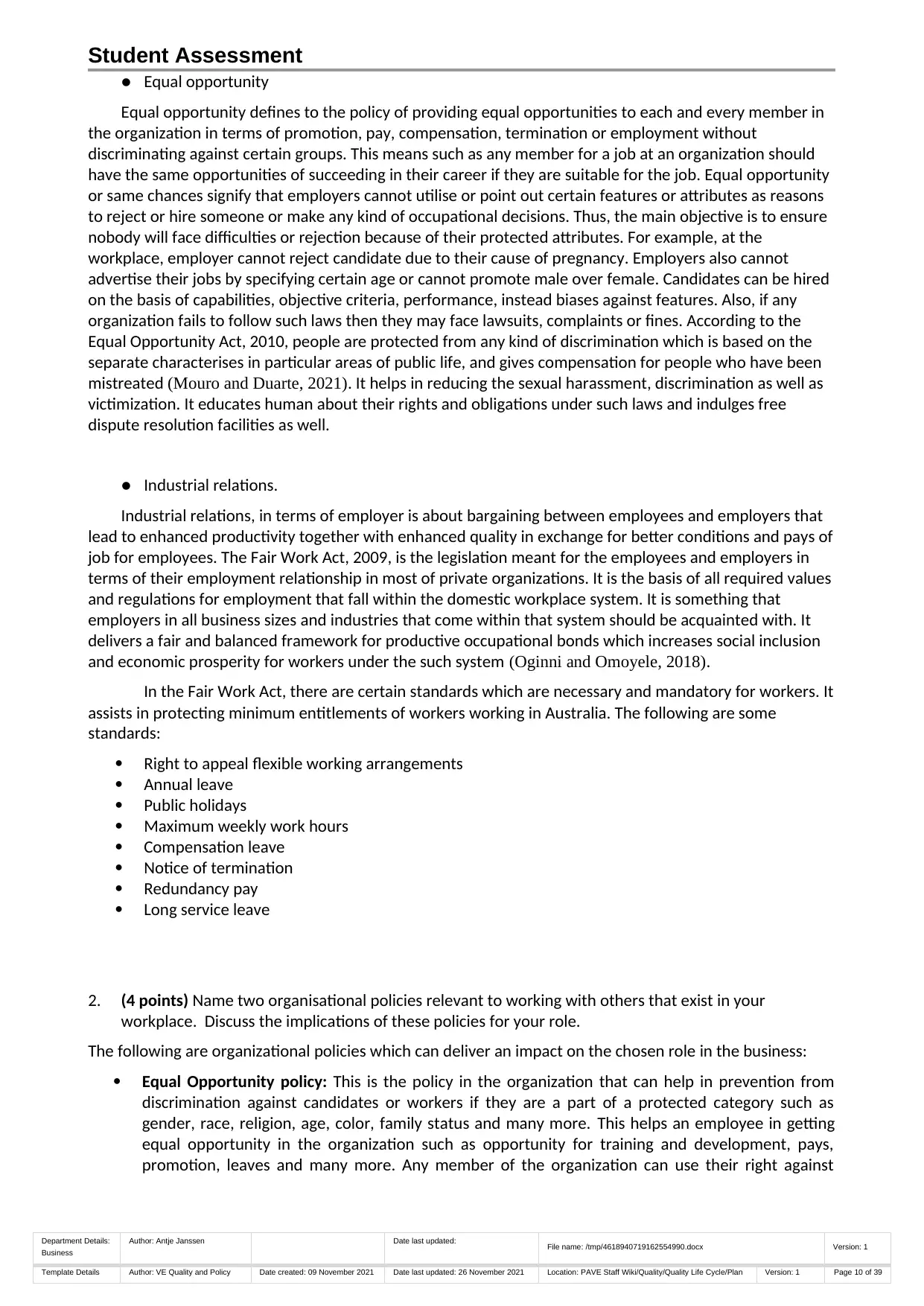
Student Assessment
● Equal opportunity
Equal opportunity defines to the policy of providing equal opportunities to each and every member in
the organization in terms of promotion, pay, compensation, termination or employment without
discriminating against certain groups. This means such as any member for a job at an organization should
have the same opportunities of succeeding in their career if they are suitable for the job. Equal opportunity
or same chances signify that employers cannot utilise or point out certain features or attributes as reasons
to reject or hire someone or make any kind of occupational decisions. Thus, the main objective is to ensure
nobody will face difficulties or rejection because of their protected attributes. For example, at the
workplace, employer cannot reject candidate due to their cause of pregnancy. Employers also cannot
advertise their jobs by specifying certain age or cannot promote male over female. Candidates can be hired
on the basis of capabilities, objective criteria, performance, instead biases against features. Also, if any
organization fails to follow such laws then they may face lawsuits, complaints or fines. According to the
Equal Opportunity Act, 2010, people are protected from any kind of discrimination which is based on the
separate characterises in particular areas of public life, and gives compensation for people who have been
mistreated (Mouro and Duarte, 2021). It helps in reducing the sexual harassment, discrimination as well as
victimization. It educates human about their rights and obligations under such laws and indulges free
dispute resolution facilities as well.
● Industrial relations.
Industrial relations, in terms of employer is about bargaining between employees and employers that
lead to enhanced productivity together with enhanced quality in exchange for better conditions and pays of
job for employees. The Fair Work Act, 2009, is the legislation meant for the employees and employers in
terms of their employment relationship in most of private organizations. It is the basis of all required values
and regulations for employment that fall within the domestic workplace system. It is something that
employers in all business sizes and industries that come within that system should be acquainted with. It
delivers a fair and balanced framework for productive occupational bonds which increases social inclusion
and economic prosperity for workers under the such system (Oginni and Omoyele, 2018).
In the Fair Work Act, there are certain standards which are necessary and mandatory for workers. It
assists in protecting minimum entitlements of workers working in Australia. The following are some
standards:
Right to appeal flexible working arrangements
Annual leave
Public holidays
Maximum weekly work hours
Compensation leave
Notice of termination
Redundancy pay
Long service leave
2. (4 points) Name two organisational policies relevant to working with others that exist in your
workplace. Discuss the implications of these policies for your role.
The following are organizational policies which can deliver an impact on the chosen role in the business:
Equal Opportunity policy: This is the policy in the organization that can help in prevention from
discrimination against candidates or workers if they are a part of a protected category such as
gender, race, religion, age, color, family status and many more. This helps an employee in getting
equal opportunity in the organization such as opportunity for training and development, pays,
promotion, leaves and many more. Any member of the organization can use their right against
Department Details:
Business
Author: Antje Janssen Date last updated: File name: /tmp/4618940719162554990.docx Version: 1
Template Details Author: VE Quality and Policy Date created: 09 November 2021 Date last updated: 26 November 2021 Location: PAVE Staff Wiki/Quality/Quality Life Cycle/Plan Version: 1 Page 10 of 39
● Equal opportunity
Equal opportunity defines to the policy of providing equal opportunities to each and every member in
the organization in terms of promotion, pay, compensation, termination or employment without
discriminating against certain groups. This means such as any member for a job at an organization should
have the same opportunities of succeeding in their career if they are suitable for the job. Equal opportunity
or same chances signify that employers cannot utilise or point out certain features or attributes as reasons
to reject or hire someone or make any kind of occupational decisions. Thus, the main objective is to ensure
nobody will face difficulties or rejection because of their protected attributes. For example, at the
workplace, employer cannot reject candidate due to their cause of pregnancy. Employers also cannot
advertise their jobs by specifying certain age or cannot promote male over female. Candidates can be hired
on the basis of capabilities, objective criteria, performance, instead biases against features. Also, if any
organization fails to follow such laws then they may face lawsuits, complaints or fines. According to the
Equal Opportunity Act, 2010, people are protected from any kind of discrimination which is based on the
separate characterises in particular areas of public life, and gives compensation for people who have been
mistreated (Mouro and Duarte, 2021). It helps in reducing the sexual harassment, discrimination as well as
victimization. It educates human about their rights and obligations under such laws and indulges free
dispute resolution facilities as well.
● Industrial relations.
Industrial relations, in terms of employer is about bargaining between employees and employers that
lead to enhanced productivity together with enhanced quality in exchange for better conditions and pays of
job for employees. The Fair Work Act, 2009, is the legislation meant for the employees and employers in
terms of their employment relationship in most of private organizations. It is the basis of all required values
and regulations for employment that fall within the domestic workplace system. It is something that
employers in all business sizes and industries that come within that system should be acquainted with. It
delivers a fair and balanced framework for productive occupational bonds which increases social inclusion
and economic prosperity for workers under the such system (Oginni and Omoyele, 2018).
In the Fair Work Act, there are certain standards which are necessary and mandatory for workers. It
assists in protecting minimum entitlements of workers working in Australia. The following are some
standards:
Right to appeal flexible working arrangements
Annual leave
Public holidays
Maximum weekly work hours
Compensation leave
Notice of termination
Redundancy pay
Long service leave
2. (4 points) Name two organisational policies relevant to working with others that exist in your
workplace. Discuss the implications of these policies for your role.
The following are organizational policies which can deliver an impact on the chosen role in the business:
Equal Opportunity policy: This is the policy in the organization that can help in prevention from
discrimination against candidates or workers if they are a part of a protected category such as
gender, race, religion, age, color, family status and many more. This helps an employee in getting
equal opportunity in the organization such as opportunity for training and development, pays,
promotion, leaves and many more. Any member of the organization can use their right against
Department Details:
Business
Author: Antje Janssen Date last updated: File name: /tmp/4618940719162554990.docx Version: 1
Template Details Author: VE Quality and Policy Date created: 09 November 2021 Date last updated: 26 November 2021 Location: PAVE Staff Wiki/Quality/Quality Life Cycle/Plan Version: 1 Page 10 of 39
Paraphrase This Document
Need a fresh take? Get an instant paraphrase of this document with our AI Paraphraser

Student Assessment
workplace harassment or discrimination or violence and many more (Heymann, Wong and
Waisath, 2022)
Workplace health and safety: It is essential for the employers to give safe and healthy work
surroundings so that employees can work without any harm or damage in the workplace. It can
also costs organization while damaging their brand reputation in the market if not handled
properly. Employees also should be trained and educated in order to use equipment, tools or
technology so that they can understand how to use such things safely. If employees do not know
how machinery or any tool can be used to work, it can create unsafe environment to all members
in which employees can be injured and harmed for their life time journey (Hidayah, Esfandiari
and Al-Fatih, 2021).
3. (10 points) Define each type of question listed below and give one example of how each type of
question may be used to work as part of a team:
A question can be defined as a sentence that looks for a solution or answer for data collection,
research and test. Right questions make precise responses and support in gathering actionable qualitative
and quantitative data. Such questions have been produced in different types and some of them are
mentioned below:
a. Open question
Open questions are not similar to the closed questions as they lengthier in nature and requires more
thoughtful process in order to get answers and discussions. Such kind of questions do not invite “yes” or
“no” answers. It involves deep listening to get the answer in the detail. This form of questions needs to
respondents to answer in their own words. It can give investigators with more data than a usual yes or no
answer. Workplaces must get feedback from their employees and asking open questions is best for such
intentions (Karpuz, Kim and Ozkan, 2020).
One of the key examples is “What knowledge do you have about the employment rights that can help in
protecting you from discrimination or harassment?”
b. Closed question.
Closed questions have two possible answers in which one answer the questions in a closes way such as
they can simply say “yes” or “no” to the asked questions. It always involves at least two answers from that
one can choose from. It helps in getting certain answers from the respondents. One can ask exactly what
they want to know by using a list of questionnaires. It can be done by using email surveys, social media,
SMS, website surveys and many more.
For example:
“Do you ever face workplace discrimination?”
Yes
No
5. (2 points) Explain how you deal with conflict in your workplace.
Organizational conflicts are the concerns raised due to the disagreements between employees in the
organization. There are several reasons due to which workplace conflicts increases such as opposing beliefs,
ideas or interests. These conflicts are not pleasant and can cause in the fall in productivity of employees.
Clarify what is the source of conflicts: It is idea to know or identify the reasons of raised issues or
conflicts at workplace, so it can be best source of resolving conflicts. Understanding the reasons
behind conflicts can enable a person to understand how such problem came to grow at prior place.
Furthermore, it will be easy to get both involved parties to consent to what the argument is. It will
also help in meeting the unmet needs of parties.
Department Details:
Business
Author: Antje Janssen Date last updated: File name: /tmp/4618940719162554990.docx Version: 1
Template Details Author: VE Quality and Policy Date created: 09 November 2021 Date last updated: 26 November 2021 Location: PAVE Staff Wiki/Quality/Quality Life Cycle/Plan Version: 1 Page 11 of 39
workplace harassment or discrimination or violence and many more (Heymann, Wong and
Waisath, 2022)
Workplace health and safety: It is essential for the employers to give safe and healthy work
surroundings so that employees can work without any harm or damage in the workplace. It can
also costs organization while damaging their brand reputation in the market if not handled
properly. Employees also should be trained and educated in order to use equipment, tools or
technology so that they can understand how to use such things safely. If employees do not know
how machinery or any tool can be used to work, it can create unsafe environment to all members
in which employees can be injured and harmed for their life time journey (Hidayah, Esfandiari
and Al-Fatih, 2021).
3. (10 points) Define each type of question listed below and give one example of how each type of
question may be used to work as part of a team:
A question can be defined as a sentence that looks for a solution or answer for data collection,
research and test. Right questions make precise responses and support in gathering actionable qualitative
and quantitative data. Such questions have been produced in different types and some of them are
mentioned below:
a. Open question
Open questions are not similar to the closed questions as they lengthier in nature and requires more
thoughtful process in order to get answers and discussions. Such kind of questions do not invite “yes” or
“no” answers. It involves deep listening to get the answer in the detail. This form of questions needs to
respondents to answer in their own words. It can give investigators with more data than a usual yes or no
answer. Workplaces must get feedback from their employees and asking open questions is best for such
intentions (Karpuz, Kim and Ozkan, 2020).
One of the key examples is “What knowledge do you have about the employment rights that can help in
protecting you from discrimination or harassment?”
b. Closed question.
Closed questions have two possible answers in which one answer the questions in a closes way such as
they can simply say “yes” or “no” to the asked questions. It always involves at least two answers from that
one can choose from. It helps in getting certain answers from the respondents. One can ask exactly what
they want to know by using a list of questionnaires. It can be done by using email surveys, social media,
SMS, website surveys and many more.
For example:
“Do you ever face workplace discrimination?”
Yes
No
5. (2 points) Explain how you deal with conflict in your workplace.
Organizational conflicts are the concerns raised due to the disagreements between employees in the
organization. There are several reasons due to which workplace conflicts increases such as opposing beliefs,
ideas or interests. These conflicts are not pleasant and can cause in the fall in productivity of employees.
Clarify what is the source of conflicts: It is idea to know or identify the reasons of raised issues or
conflicts at workplace, so it can be best source of resolving conflicts. Understanding the reasons
behind conflicts can enable a person to understand how such problem came to grow at prior place.
Furthermore, it will be easy to get both involved parties to consent to what the argument is. It will
also help in meeting the unmet needs of parties.
Department Details:
Business
Author: Antje Janssen Date last updated: File name: /tmp/4618940719162554990.docx Version: 1
Template Details Author: VE Quality and Policy Date created: 09 November 2021 Date last updated: 26 November 2021 Location: PAVE Staff Wiki/Quality/Quality Life Cycle/Plan Version: 1 Page 11 of 39
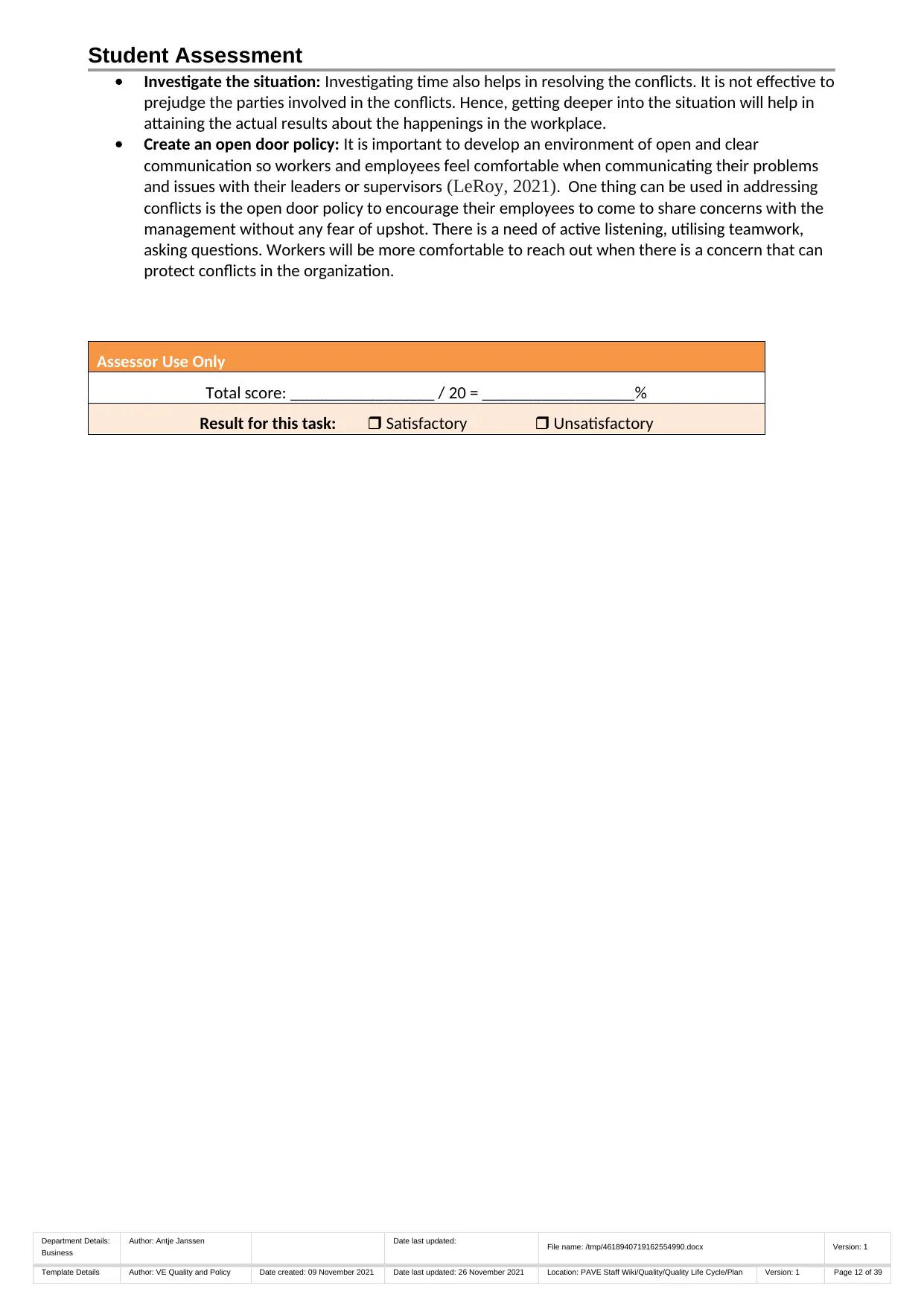
Student Assessment
Investigate the situation: Investigating time also helps in resolving the conflicts. It is not effective to
prejudge the parties involved in the conflicts. Hence, getting deeper into the situation will help in
attaining the actual results about the happenings in the workplace.
Create an open door policy: It is important to develop an environment of open and clear
communication so workers and employees feel comfortable when communicating their problems
and issues with their leaders or supervisors (LeRoy, 2021). One thing can be used in addressing
conflicts is the open door policy to encourage their employees to come to share concerns with the
management without any fear of upshot. There is a need of active listening, utilising teamwork,
asking questions. Workers will be more comfortable to reach out when there is a concern that can
protect conflicts in the organization.
Assessor Use Only
Total score: _________________ / 20 = __________________%
Result for this task: Satisfactory Unsatisfactory
Department Details:
Business
Author: Antje Janssen Date last updated: File name: /tmp/4618940719162554990.docx Version: 1
Template Details Author: VE Quality and Policy Date created: 09 November 2021 Date last updated: 26 November 2021 Location: PAVE Staff Wiki/Quality/Quality Life Cycle/Plan Version: 1 Page 12 of 39
Investigate the situation: Investigating time also helps in resolving the conflicts. It is not effective to
prejudge the parties involved in the conflicts. Hence, getting deeper into the situation will help in
attaining the actual results about the happenings in the workplace.
Create an open door policy: It is important to develop an environment of open and clear
communication so workers and employees feel comfortable when communicating their problems
and issues with their leaders or supervisors (LeRoy, 2021). One thing can be used in addressing
conflicts is the open door policy to encourage their employees to come to share concerns with the
management without any fear of upshot. There is a need of active listening, utilising teamwork,
asking questions. Workers will be more comfortable to reach out when there is a concern that can
protect conflicts in the organization.
Assessor Use Only
Total score: _________________ / 20 = __________________%
Result for this task: Satisfactory Unsatisfactory
Department Details:
Business
Author: Antje Janssen Date last updated: File name: /tmp/4618940719162554990.docx Version: 1
Template Details Author: VE Quality and Policy Date created: 09 November 2021 Date last updated: 26 November 2021 Location: PAVE Staff Wiki/Quality/Quality Life Cycle/Plan Version: 1 Page 12 of 39
⊘ This is a preview!⊘
Do you want full access?
Subscribe today to unlock all pages.

Trusted by 1+ million students worldwide
1 out of 39
Related Documents
Your All-in-One AI-Powered Toolkit for Academic Success.
+13062052269
info@desklib.com
Available 24*7 on WhatsApp / Email
![[object Object]](/_next/static/media/star-bottom.7253800d.svg)
Unlock your academic potential
Copyright © 2020–2025 A2Z Services. All Rights Reserved. Developed and managed by ZUCOL.





